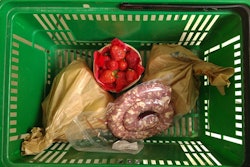
Balancing supply with demand is an ongoing challenge for grocers. With perishable foods and cost management at the forefront, grocers often find themselves in reactive mode. E-commerce brings a whole new dimension to the equation.
So, what are the best actions for grocers to take right now with their e-commerce efforts?
1) Research technology trends. The industry already knows that more business will be conducted online, so the key is to be ready for it. “From my perspective, people should not be looking at today’s technology, but at what the technology is likely to be like in five or 10 years,” said Malouli.
2) Don’t be late to market. The online segment of food and beverage sales is still very small, but that’s no excuse to wait. The first into the space, with the best processes and technology, will be best positioned to capture this market when it explodes.
3) Integrate your systems. The tried and true processes that support in-store retail shopping won’t all work for e-commerce. This is the time to revisit processes and systems to see if they can be enhanced, or if they need to be ticketed for replacement,
4) Look for an experienced e-commerce partner. There are companies in the supply chain, in logistics, in distribution and in online selling that already are heavily engaged in e-commerce. Even if their experience is in other industries, they know what e-commerce needs to accomplish. For small- and mid-sized companies, being able to outsource portions of their e-commerce operations can be the difference between succeeding—or not. For large food and beverage chains, the ultimate goal might be to develop your own proprietary e-commerce systems and processes because you have the internal expertise—but this takes time. While you are in the process, an outsource solution can enable you to meet your customer demands today.
5) Know your customer. Online grocery sales could reach $100 billion by 2025.A survey conducted by marketing consultancy Valassis revealed that online shoppers like to save time (66 percent); enjoy the larger selection of products (66 percent); and find the online experience easier than shopping in-store (65 percent)—but shoppers also miss the sensory experience of touching and smelling produce (64 percent) and are uncomfortable having someone else pick out their produce or other perishable items (62 percent).
While these are general statistics, every store has its brand to promote, and the job of also understanding the uniqueness of its customers. Understanding who customers are, and how they want their food and beverages delivered is central to retaining them in a highly competitive industry.
That’s what e-commerce must achieve.













![Top Tech Startup Logo 2025 Vertical [color] (1)](https://img.foodlogistics.com/mindful/acbm/workspaces/default/uploads/2025/07/top-tech-startup-logo-2025-vertical-color-1.pZkBK95TLe.png?ar=16%3A9&auto=format%2Ccompress&bg=fff&fill-color=fff&fit=fill&h=135&q=70&w=240)






